SIM card
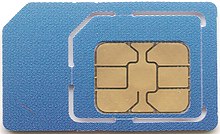
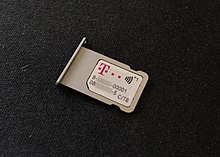
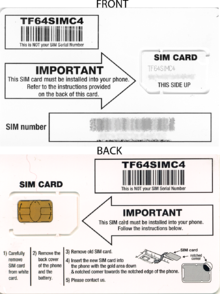
ASIM(Subscriber Identity Module)cardis anintegrated circuit(IC) intended to securely store aninternational mobile subscriber identity(IMSI) number and its related key, which are used to identify and authenticate subscribers onmobile telephonedevices (such asmobile phonesandlaptops). Technically the actual physical card is known as auniversal integrated circuit card(UICC); thissmart cardis usually made ofPVCwith embedded contacts andsemiconductors,with the SIM as its primary component. In practice the term "SIM card" is still used to refer to the entire unit and not simply the IC.
A SIM contains a unique serial number, integrated circuit card identification (ICCID), international mobile subscriber identity (IMSI) number, security authentication and ciphering information, temporary information related to the local network, a list of the services the user has access to, and four passwords: apersonal identification number(PIN) for ordinary use, and apersonal unblocking key(PUK) for PIN unlocking as well as a second pair (called PIN2 and PUK2 respectively) which are used for managingfixed dialing numberand some other functionality.[1][2]In Europe, the serial SIM number (SSN) is also sometimes accompanied by aninternational article number(IAN) or aEuropean article number(EAN) required when registering online for the subscription of a prepaid card. It is also possible to store contact information on many SIM cards.
SIMs are always used onGSMphones; forCDMAphones, they are needed only forLTE-capable handsets. SIM cards are also used insatellite phones,smart watches, computers, or cameras.[3]
The first SIM cards were the size of credit and bank cards. Sizes were reduced several times over the years, usually keeping electrical contacts the same, to fit smaller-sized devices.[4]
SIMs are transferable between different mobile devices by removing the card itself. As of 2020,eSIMis superseding physical SIM cards in some domains, including cellular telephony. eSIM uses a software-based SIM embedded into an irremovableeUICC.
History and procurement[edit]
The SIM card is a type ofsmart card,[3]the basis for which is thesiliconintegrated circuit(IC) chip.[5]The idea of incorporating a silicon IC chip onto a plastic card originates from the late 1960s.[5]Smart cards have since usedMOS integrated circuitchips, along withMOS memorytechnologies such asflash memoryandEEPROM(electricallyEPROM).[6]
The SIM was initially specified by theETSIin the specification TS 11.11. This describes the physical and logical behaviour of the SIM. With the development ofUMTS,the specification work was partially transferred to3GPP.3GPP is now responsible for the further development of applications like SIM (TS 51.011[7]) and USIM (TS 31.102[8]) and ETSI for the further development of the physical cardUICC.
The first SIM card was developed in 1991 by Munich smart-card makerGiesecke+Devrient,who sold the first 300 SIM cards to the Finnish wireless network operatorRadiolinja.[9][10]
Today (2023), SIM cards are ubiquitous, allowing over 8 billion devices to connect to cellular networks around the world. According to theInternational Card Manufacturers Association(ICMA), there were 5.4 billion SIM cards manufactured globally in 2016 creating over $6.5 billion in revenue for traditional SIM card vendors.[11]The rise of cellular IoT and 5G networks was predicted by Ericsson to drive the growth of the addressable market for SIM cards to over 20 billion devices by 2020.[12]The introduction ofembedded-SIM(eSIM) andremote SIM provisioning(RSP) from the GSMA[13]may disrupt the traditional SIM card ecosystem with the entrance of new players specializing in "digital" SIM card provisioning and other value-added services for mobile network operators.[6]
Design[edit]

There are three operating voltages for SIM cards:5 V,3 Vand1.8 V(ISO/IEC 7816-3 classes A, B and C, respectively). The operating voltage of the majority of SIM cards launched before 1998 was5 V.SIM cards produced subsequently are compatible with3 Vand5 V.Modern cards support5 V,3 Vand1.8 V.[6]
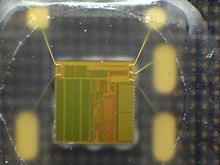
Modern SIM cards allow applications to load when the SIM is in use by the subscriber. These applications communicate with the handset or a server usingSIM Application Toolkit,which was initially specified by3GPPin TS 11.14. (There is an identical ETSI specification with different numbering.) ETSI and 3GPP maintain the SIM specifications. The main specifications are: ETSI TS 102 223 (the toolkit for smart cards), ETSI TS 102 241 (API), ETSI TS 102 588 (application invocation), and ETSI TS 131 111 (toolkit for more SIM-likes). SIM toolkit applications were initially written in native code using proprietary APIs. To provide interoperability of the applications, ETSI choseJava Card.[14]A multi-company collaboration called GlobalPlatform defines some extensions on the cards, with additional APIs and features like more cryptographic security andRFIDcontactless use added.[15]
Data[edit]
SIM cards store network-specific information used to authenticate and identify subscribers on the network. The most important of these are the ICCID, IMSI,authentication key (Ki),local area identity (LAI) and operator-specific emergency number. The SIM also stores other carrier-specific data such as the SMSC (Short Message service center) number, service provider name (SPN), service dialing numbers (SDN), advice-of-charge parameters and value-added service (VAS) applications. (Refer to GSM 11.11.[16])
SIM cards can come in various data capacities, from8 KBto at least256 KB.[10]All can store a maximum of 250 contacts on the SIM, but while the32 KBhas room for 33Mobile country code(MCCs) ornetwork identifiers,the64 KBversion has room for 80 MNCs.[17]This is used by network operators to store data on preferred networks, mostly used when the SIM is not in its home network but isroaming.The network operator that issued the SIM card can use this to have a phone connect to a preferred network that is more economic for the provider instead of having to pay the network operator that the phone discovered first. This does not mean that a phone containing this SIM card can connect to a maximum of only 33 or 80 networks, instead it means that the SIM card issuer can specify only up to that number of preferred networks. If a SIM is outside these preferred networks, it uses the first or best available network.[12]
ICCID[edit]
Each SIM is internationally identified by itsintegrated circuit card identifier(ICCID). Nowadays ICCID numbers are also used to identify eSIM profiles, not only physical SIM cards. ICCIDs are stored in the SIM cards and are also engraved or printed on the SIM card body during a process called personalisation.
The ICCID is defined by the ITU-T recommendationE.118as theprimary account number.[18]Its layout is based onISO/IEC 7812.According to E.118, the number can be up to 19 digits long, including a single check digit calculated using theLuhn algorithm.However, the GSM Phase 1[19]defined the ICCID length as an opaque data field, 10 octets (20 digits) in length, whose structure is specific to amobile network operator.
The number is composed of the following subparts:
Issuer identification number (IIN)
Maximum of seven digits:
- Major industry identifier (MII), 2 fixed digits,89for telecommunication purposes.
- Country code,2 or 3 digits, as defined byITU-TrecommendationE.164.
- NANPcountries, apart from Canada, use01,i.e. prepending a zero to their common calling code +1
- Canadauses302
- Russiauses701,i.e. appending 01 to its calling code +7
- Kazakhstanuses997,even though it shares the calling code +7 with Russia
- Issuer identifier, 1–4 digits.
- Often identical to theMobile country code(MCC).[20]
Individual account identification
- Individual account identification number. Its length is variable, but every number under one IIN has the same length.
- Often identical to theMobile identification number(MIN).[5]
Check digit
- Single digit calculated from the other digits using theLuhn algorithm.
With the GSM Phase 1 specification using 10octetsinto which ICCID is stored as packed BCD[clarification needed],the data field has room for 20 digits with hexadecimal digit "F" being used as filler when necessary. In practice, this means that on GSM cards there are 20-digit (19+1) and 19-digit (18+1) ICCIDs in use, depending upon the issuer. However, a single issuer always uses the same size for its ICCIDs.
As required by E.118, the ITU-T updates a list of all current internationally assigned IIN codes in its Operational Bulletins which are published twice a month (the last as of January 2019 was No. 1163 from 1 January 2019).[21]ITU-T also publishes complete lists: as of August 2023, the list issued on 1 December 2018 was current, having all issuer identifier numbers before 1 December 2018.[22]
International mobile subscriber identity (IMSI)[edit]
SIM cards are identified on their individual operator networks by a uniqueinternational mobile subscriber identity(IMSI).Mobile network operatorsconnect mobile phone calls and communicate with their market SIM cards using their IMSIs. The format is:
- The first three digits represent theMobile country code(MCC).
- The next two or three digits represent theMobile network code(MNC). Three-digit MNC codes are allowed by E.212 but are mainly used in the United States and Canada. One MCC can have both 2 digit and 3 digit MNCs, an example is 350 007.
- The next digits represent theMobile identification number(MSIN).
- Normally there are 10 digits, but can be fewer in the case of a 3-digit MNC or if national regulations indicate that the total length of the IMSI should be less than 15 digits.
- Digits are different from country to country.
Authentication key (Ki)[edit]
The Kiis a 128-bit value used in authenticating the SIMs on aGSMmobile network (for USIM network, the Kiis still needed but other parameters are also needed). Each SIM holds a unique Kiassigned to it by the operator during the personalisation process. The Kiis also stored in a database (termedauthentication centeror AuC) on the carrier's network.
The SIM card is designed to prevent someone from getting the Kiby using thesmart-card interface.Instead, the SIM card provides a function,Run GSM Algorithm,that the phone uses to pass data to the SIM card to be signed with the Ki.This, by design, makes using the SIM card mandatory unless the Kican be extracted from the SIM card, or the carrier is willing to reveal the Ki.In practice, the GSM cryptographic algorithm for computing a signed response (SRES_1/SRES_2: see steps 3 and 4, below) from the Kihas certain vulnerabilities[17]that can allow the extraction of the Kifrom a SIM card and the making of aduplicate SIM card.
Authentication process:
- When the mobile equipment starts up, it obtains the international mobile subscriber identity (IMSI) from the SIM card, and passes this to the mobile operator, requesting access and authentication. The mobile equipment may have to pass a PIN to the SIM card before the SIM card reveals this information.
- The operator network searches its database for the incoming IMSI and its associated Ki.
- The operator network then generates a random number (RAND, which is anonce) and signs it with the Kiassociated with the IMSI (and stored on the SIM card), computing another number, that is split into the Signed Response 1 (SRES_1, 32 bits) and the encryption key Kc(64 bits).
- The operator network then sends the RAND to the mobile equipment, which passes it to the SIM card. The SIM card signs it with its Ki,producing Signed Response 2 (SRES_2) and Kc,which it gives to the mobile equipment. The mobile equipment passes SRES_2 on to the operator network.
- The operator network then compares its computed SRES_1 with the computed SRES_2 that the mobile equipment returned. If the two numbers match, the SIM is authenticated and the mobile equipment is granted access to the operator's network. Kcis used to encrypt all further communications between the mobile equipment and the operator.
Location area identity[edit]
The SIM stores network state information, which is received from thelocation area identity(LAI). Operator networks are divided into location areas, each having a unique LAI number. When the device changes locations, it stores the new LAI to the SIM and sends it back to the operator network with its new location. If the device is power cycled, it takes data off the SIM, and searches for the prior LAI.
SMS messages and contacts[edit]
Most SIM cards store a number of SMS messages and phone book contacts. It stores the contacts in simple "name and number" pairs. Entries that contain multiple phone numbers and additional phone numbers are usually not stored on the SIM card. When a user tries to copy such entries to a SIM, the handset's software breaks them into multiple entries, discarding information that is not a phone number. The number of contacts and messages stored depends on the SIM; early models stored as few as five messages and 20 contacts, while modern SIM cards can usually store over 250 contacts.[23]
Formats[edit]
SIM cards have been made smaller over the years; functionality is independent of format. Full-size SIM was followed by mini-SIM, micro-SIM, and nano-SIM. SIM cards are also made to embed in devices.

| SIM card format | Introduced | Standard reference | Length | Width | Thickness |
|---|---|---|---|---|---|
| Full-size (1FF) | 1991 | ISO/IEC 7810:2003, ID-1 | 85.6 mm (3.37 in) | 53.98 mm (2.125 in) | 0.76 mm (0.030 in) |
| Mini-SIM (2FF) | 1996 | ISO/IEC 7810:2003, ID-000 | 25 mm (0.98 in) | 15 mm (0.59 in) | 0.76 mm (0.030 in) |
| Micro-SIM (3FF) | 2003 | ETSITS 102 221 V9.0.0, Mini-UICC | 15 mm (0.59 in) | 12 mm (0.47 in) | 0.76 mm (0.030 in) |
| Nano-SIM (4FF) | early 2012 | ETSI TS 102 221 V11.0.0 | 12.3 mm (0.48 in) | 8.8 mm (0.35 in) | 0.67 mm (0.026 in) |
| Embedded-SIM (eSIM) |
2016 | ETSI TS 102.671 V9.0.0
JEDECDesign Guide 4.8, SON-8 |
— | — | — |
All versions of the non-embedded SIM cards share the sameISO/IEC 7816pin arrangement.
Full-size SIM[edit]
Thefull-size SIM(or 1FF, 1st form factor) was the first form factor to appear. It was the size of acredit card(85.60 mm × 53.98 mm × 0.76 mm).
Mini-SIM[edit]


Themini-SIM(or 2FF) card has the same contact arrangement as the full-size SIM card and is normally supplied within a full-size card carrier, attached by a number of linking pieces. This arrangement (defined inISO/IEC 7810asID-1/000) lets such a card be used in a device that requires a full-size card – or in a device that requires a mini-SIM card, after breaking the linking pieces. As the full-size SIM is obsolete, some suppliers refer to the mini-SIM as a "standard SIM" or "regular SIM".
Micro-SIM[edit]
Themicro-SIM(or 3FF) card has the same thickness and contact arrangements, but reduced length and width as shown in the table above.[24]
The micro-SIM was introduced by theEuropean Telecommunications Standards Institute(ETSI) along with SCP,3GPP(UTRAN/GERAN),3GPP2(CDMA2000),ARIB,GSM Association(GSMA SCaG and GSMNA), GlobalPlatform,Liberty Alliance,and theOpen Mobile Alliance(OMA) for the purpose of fitting into devices too small for a mini-SIM card.[20][25]
The form factor was mentioned in the December 1998 3GPP SMG9UMTSWorking Party, which is the standards-setting body for GSM SIM cards,[23]and the form factor was agreed upon in late 2003.[26]
The micro-SIM was designed for backward compatibility. The major issue for backward compatibility was the contact area of the chip. Retaining the same contact area makes the micro-SIM compatible with the prior, larger SIM readers through the use of plastic cutout surrounds. The SIM was also designed to run at the same speed (5 MHz) as the prior version. The same size and positions of pins resulted in numerous "How-to" tutorials and YouTube videos with detailed instructions how to cut a mini-SIM card to micro-SIM size.
The chairman of EP SCP, Klaus Vedder, said[26]
ETSI has responded to a market need from ETSI customers, but additionally there is a strong desire not to invalidate, overnight, the existing interface, nor reduce the performance of the cards.
Micro-SIM cards were introduced by various mobile service providers for the launch of the original iPad, and later for smartphones, from April 2010. TheiPhone 4was the first smartphone to use a micro-SIM card in June 2010,[citation needed]followed by many others.
Nano-SIM[edit]
After a debate in early 2012 between a few designs created by Apple,NokiaandRIM,Apple's design for an even smaller SIM card was accepted by the ETSI.[27][28]Thenano-SIM(or 4FF) card was introduced in June 2012, when mobile service providers in various countries first supplied it for phones that supported the format. The nano-SIM measures 12.3 mm × 8.8 mm × 0.67 mm (0.484 in × 0.346 in × 0.026 in) and reduces the previous format to the contact area while maintaining the existing contact arrangements.[29]A small rim of isolating material is left around the contact area to avoid short circuits with the socket. The nano-SIM can be put into adapters for use with devices designed for 2FF or 3FF SIMs, and is made thinner for that purpose,[30]and telephone companies give due warning about this.[31]4FF is 0.67 mm (0.026 in) thick, compared to the 0.76 mm (0.030 in) of its predecessors.
TheiPhone 5,released in September 2012, was the first device to use a nano-SIM card,[32]followed by other handsets.
Security[edit]
In July 2013, Karsten Nohl, a security researcher from SRLabs, described[33][34]vulnerabilities in some SIM cards that supportedDES,which, despite its age, is still used by some operators.[34]The attack could lead to the phone being remotelyclonedor let someone steal payment credentials from the SIM.[34]Further details of the research were provided atBlackHaton 31 July 2013.[34][35]In response, theInternational Telecommunication Unionsaid that the development was "hugely significant" and that it would be contacting its members.[36]
In February 2015,The Interceptreported that theNSAandGCHQhad stolen the encryption keys (Ki's) used byGemalto(now known asThales DIS,manufacturer of 2 billion SIM cards annually)[37]), enabling these intelligence agencies to monitor voice and data communications without the knowledge or approval of cellular network providers or judicial oversight.[38]Having finished its investigation, Gemalto claimed that it has “reasonable grounds” to believe that the NSA and GCHQ carried out an operation to hack its network in 2010 and 2011, but says the number of possibly stolen keys would not have been massive.[39]
In September 2019, Cathal Mc Daid, a security researcher from Adaptive Mobile Security, described[40][41]how vulnerabilities in some SIM cards that contained the S@T Browser library were being actively exploited. This vulnerability was namedSimjacker.Attackers were using the vulnerability to track the location of thousands of mobile phone users in several countries.[42]Further details of the research were provided atVirusBulletinon 3 October 2019.[43][44]
Developments[edit]
When GSM was already in use, the specifications were further developed and enhanced with functionality such asSMSandGPRS.These development steps are referred as releases by ETSI. Within these development cycles, the SIM specification was enhanced as well: new voltage classes, formats and files were introduced.
USIM[edit]
In GSM-only times, the SIM consisted of the hardware and the software. With the advent of UMTS, this naming was split: the SIM was now an application and hence only software. The hardware part was called UICC. This split was necessary because UMTS introduced a new application, the universal subscriber identity module (USIM). The USIM brought, among other things, security improvements like mutual authentication and longer encryption keys, and an improved address book.
UICC[edit]
"SIM cards" in developed countries today are usuallyUICCscontaining at least a SIM application and a USIM application. This configuration is necessary because older GSM only handsets are solely compatible with the SIM application and some UMTS security enhancements rely on the USIM application.
Other variants[edit]
OncdmaOnenetworks, the equivalent of the SIM card is theR-UIMand the equivalent of the SIM application is theCSIM.
Avirtual SIMis a mobile phone number provided by amobile network operatorthat does not require a SIM card to connect phone calls to a user's mobile phone.
Embedded SIM (eSIM)[edit]
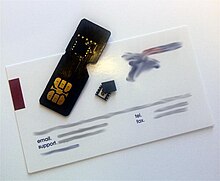
An embedded SIM (eSIM) is a form of programmable SIM that is embedded directly into a device. The surface mount format provides the same electrical interface as the full size, 2FF and 3FF SIM cards, but is soldered to a circuit board as part of the manufacturing process. InM2Mapplications where there is no requirement[13]to change the SIM card, this avoids the requirement for a connector, improving reliability and security.[citation needed]An eSIM can beprovisioned remotely;end-users can add or remove operators without the need to physically swap a SIM from the device.[45]
In September 2017,Appleintroduced theApple Watch Series 3featuringeSIM.[46]In October 2018, Apple introduced theiPad Pro (3rd generation),[47]which was the first iPad to support eSIM. In September 2022, Apple introduced theiPhone 14 serieswhich was the first eSIM exclusive iPhone in the United States.[48]
Integrated SIM (iSIM)[edit]
An integrated SIM (iSIM) is a form of SIM directly integrated into the modem chip or main processor of the device itself. As a consequence they are smaller, cheaper and more reliable than eSIMs, they can improve security and ease the logistics and production of small devices i.e. forIoTapplications. In 2021,Deutsche Telekomintroduced thenuSIM,an "Integrated SIM for IoT".[49][50][51]
Usage in mobile phone standards[edit]
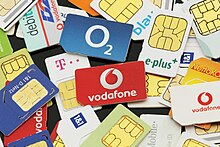
The use of SIM cards is mandatory inGSMdevices.
Thesatellite phonenetworksIridium,ThurayaandInmarsat'sBGANalso use SIM cards. Sometimes, these SIM cards work in regular GSM phones and also allow GSM customers to roam in satellite networks by using their own SIM cards in a satellite phone.
Japan's 2GPDCsystem (which was shut down in 2012;SoftBank Mobileshut down PDC from 31 March 2010) also specified a SIM, but this has never been implemented commercially. The specification of the interface between the Mobile Equipment and the SIM is given in theRCRSTD-27 annexe 4. The Subscriber Identity Module Expert Group was a committee of specialists assembled by the European Telecommunications Standards Institute (ETSI) to draw up the specifications (GSM11.11) for interfacing between smart cards and mobile telephones. In 1994, the name SIMEG was changed to SMG9.
Japan's current and next-generation cellular systems are based on W-CDMA (UMTS) andCDMA2000and all use SIM cards. However, Japanese CDMA2000-based phones are locked to the R-UIM they are associated with and thus, the cards are not interchangeable with other Japanese CDMA2000 handsets (though they may be inserted into GSM/WCDMA handsets for roaming purposes outside Japan).
CDMA-based devices originally did not use a removable card, and the service for these phones is bound to a unique identifier contained in the handset itself. This is most prevalent in operators in the Americas. The first publication of the TIA-820 standard (also known as 3GPP2 C.S0023) in 2000 defined the Removable User Identity Module (R-UIM). Card-based CDMA devices are most prevalent in Asia.
The equivalent of a SIM inUMTSis called the universal integrated circuit card (UICC), which runs a USIM application. The UICC is still colloquially called aSIM card.[52]
SIM and carriers[edit]
The SIM card introduced a new and significant business opportunity forMVNOswho lease capacity from one of the network operators rather than owning or operating a cellular telecoms network and only provide a SIM card to their customers. MVNOs first appeared in Denmark, Hong Kong, Finland and the UK. Today they exist in over 50 countries, including most of Europe, the United States, Canada, Mexico, Australia and parts of Asia, and account for approximately 10% of all mobile phone subscribers around the world.[53]
On some networks, the mobile phone islocked to its carrier SIM card,meaning that the phone only works with SIM cards from the specific carrier. This is more common in markets where mobile phones are heavily subsidised by the carriers, and the business model depends on the customer staying with the service provider for a minimum term (typically 12, 18 or 24 months). SIM cards that are issued by providers with an associated contract are calledSIM-onlydeals. Common examples are the GSM networks in the United States, Canada, Australia, the UK and Poland. Many businesses offer the ability to remove the SIM lock from a phone, effectively making it possible to then use the phone on any network by inserting a different SIM card. Mostly, GSM and 3G mobile handsets can easily be unlocked and used on any suitable network with any SIM card.
In countries where the phones are not subsidised, e.g., India, Israel and Belgium, all phones are unlocked. Where the phone is not locked to its SIM card, the users can easily switch networks by simply replacing the SIM card of one network with that of another while using only one phone. This is typical, for example, among users who may want to optimise their carrier's traffic by different tariffs to different friends on different networks, or when travelling internationally.
In 2016, carriers started using the concept of automatic SIM reactivation[54]whereby they let users reuse expired SIM cards instead of purchasing new ones when they wish to re-subscribe to that operator. This is particularly useful in countries whereprepaid callsdominate and where competition drives highchurn rates,as users had to return to a carrier shop to purchase a new SIM each time they wanted to churn back to an operator.
SIM-only[edit]
Commonly sold as a product by mobiletelecommunicationscompanies, "SIM-only" refers to a type oflegally liabilitycontract between a mobile network provider and a customer. The contract itself takes the form of a credit agreement and is subject to a credit check.
Within a SIM-only contract, the mobile network provider supplies their customer with just one piece of hardware, a SIM card, which includes an agreed amount of network usage in exchange for a monthly payment. Network usage within a SIM-only contract can be measured in minutes, text, data or any combination of these. The duration of a SIM-only contract varies depending on the deal selected by the customer, but in the UK they are typically available over 1, 3, 6, 12 or 24-month periods.
SIM-only contracts differ from mobile phone contracts in that they do not include any hardware other than a SIM card. In terms of network usage, SIM-only is typically more cost-effective than other contracts because the provider does not charge more to offset the cost of a mobile device over the contract period. The short contract length is one of the key features of SIM-only – made possible by the absence of a mobile device.
SIM-only is increasing in popularity very quickly.[55]In 2010 pay monthly based mobile phone subscriptions grew from 41 per cent to 49 per cent of all UK mobile phone subscriptions.[56]According to German research companyGfK,250,000 SIM-only mobile contracts were taken up in the UK during July 2012 alone, the highest figure since GfK began keeping records.
Increasing smartphone penetration combined with financial concerns is leading customers to save money by moving onto a SIM-only when their initial contract term is over.
Multiple-SIM devices[edit]

Dual SIMdevices have two SIM card slots for the use of two SIM cards, from one or multiple carriers. Multiple SIM devices are commonplace in developing markets such as inAfrica,East Asia,South AsiaandSoutheast Asia,where variable billing rates, network coverage and speed make it desirable for consumers to use multiple SIMs from competing networks. Dual-SIM phones are also useful to separate one's personal phone number from a business phone number, without having to carry multiple devices. Some popular devices, such as theBlackBerry KeyOne,have dual-SIM variants; however, dual-SIM devices were not common in the US or Europe due to lack of demand. This has changed with mainline products from Apple and Google featuring either two SIM slots or a combination of a physical SIM slot and an eSIM.
In September 2018,AppleintroducediPhone XS,iPhone XS Max,andiPhone XRfeaturing Dual SIM (nano-SIM andeSIM) andApple Watch Series 4featuring DualeSIM.
Thin SIM[edit]

Athin SIM(oroverlay SIMorSIM overlay) is a very thin device shaped like a SIM card, approximately 120 microns (1⁄200inch) thick. It has contacts on its front and back. It is used by placing it on top of a regular SIM card. It provides its own functionality while passing through the functionality of the SIM card underneath. It can be used to bypass the mobile operating network and run custom applications, particularly on non-programmable cell phones.[57]
Its top surface is a connector that connects to the phone in place of the normal SIM. Its bottom surface is a connector that connects to the SIM in place of the phone. With electronics, it can modify signals in either direction, thus presenting a modified SIM to the phone, and/or presenting a modified phone to the SIM. (It is a similar concept to theGame Genie,which connects between a game console and a game cartridge, creating a modified game). Similar devices have also been developed for iPhones to circumvent SIM card restrictions on carrier-locked models.[58]
In 2014,Equitel,an MVNO operated by Kenya'sEquity Bank,announced its intention to begin issuing thin SIMs to customers, raising security concerns by competition, particularly concerning the safety of mobile money accounts. However, after months of security testing and legal hearings before the country's Parliamentary Committee on Energy, Information and Communications, theCommunications Authority of Kenya(CAK) gave the bank the green light to roll out its thin SIM cards.[59]
See also[edit]
- Apple SIM
- eSIM
- GSM 03.48
- International Mobile Equipment Identity(IMEI)
- IP Multimedia Services Identity Module(ISIM)
- Mobile broadband
- Mobile equipment identifier(MEID)
- Mobile signature
- Regional lockout
- SIM cloning
- SIM connector
- Single Wire Protocol(SWP)
- Tethering
- Transponder
- GSM USSD codes– Unstructured Supplementary Service Data: list of standard GSM codes for network and SIM related functions
- VMAC
- W-SIM(Willcom-SIM)
References[edit]
- ^"Calling Features on Your Samsung Galaxy Phone".Samsung.Limit Calling to Specific Numbers.Retrieved19 April2022.
- ^"Access codes".Nokia.
- ^abTait, Don (25 August 2016)."Smart card IC shipments to reach 12.8 billion units in 2021".IHS Technology.IHS Markit.Archivedfrom the original on 24 October 2019.Retrieved24 October2019.
- ^GSMA Intelligence."Understanding SIM evolution"(PDF).GSMA Intelligence.GSMA.Archived(PDF)from the original on 20 March 2023.Retrieved31 May2023.
- ^abcChen, Zhiqun (2000).Java Card Technology for Smart Cards: Architecture and Programmer's Guide.Addison-Wesley Professional.pp. 3–4.ISBN9780201703290.
- ^abcVeendrick, Harry J. M. (2017).Nanometer CMOS ICs: From Basics to ASICs.Springer. pp. 315, 481–2.ISBN9783319475974.
- ^"3GPP specification: 51.011".Archivedfrom the original on 28 April 2016.Retrieved29 April2016.
- ^"3GPP specification: 31.102".Archivedfrom the original on 14 April 2016.Retrieved29 April2016.
- ^Asif, Saad Z. (2011).Next Generation Mobile Communications Ecosystem.John Wiley & Sons. p. 306.ISBN978-1119995814.
- ^ab"G&D – History of Giesecke & Devrient".Archived fromthe originalon 24 September 2015.Retrieved29 April2016.
- ^"Official Publication of the International Card Manufacturers Association February 2017 Volume 27 No1"(PDF).Retrieved28 May2017.[permanent dead link]
- ^ab"Ericsson Mobility Report November 2015"(PDF).Archived(PDF)from the original on 17 March 2017.Retrieved28 May2017.
- ^ab"GSMA Embedded SIM and RSP".Archivedfrom the original on 7 June 2017.Retrieved28 May2017.
- ^"ETSI TS 102 241: UICC API for Java Card™ Release 13"(PDF).Archived(PDF)from the original on 8 March 2021.Retrieved8 August2019.
- ^"Specifications Archive: Secure Element (Card)".GlobalPlatform.Archivedfrom the original on 31 July 2019.Retrieved8 August2019.
- ^"3GPP specification: 11.11".Archivedfrom the original on 18 August 2016.Retrieved29 April2016.
- ^ab"Hackers crack open mobile network".bbc.co.uk. 20 April 2011.Archivedfrom the original on 12 August 2011.Retrieved13 August2011.
- ^ITU-T, ITU-T RecommendationE.118,The international telecommunication charge card,Revision historyArchived17 October 2012 at theWayback Machine,Revision "05/2006"Archived4 March 2016 at theWayback Machine
- ^ETSI, ETSI Recommendation GSM 11.11, Specifications of the SIM-ME Interface,Version 3.16.0Archived27 November 2007 at theWayback Machine
- ^abGaby Lenhart (1 April 2006)."The Smart Card Platform".ETSI Technical Committee Smart Card Platform (TB SCP).Archivedfrom the original on 24 August 2013.Retrieved30 January2010.
SCP is co-operating on both technical and service aspects with a number of other committees both within and outside the telecommunications sector.
- ^"Operational Bulletin No. 1163 (1.I.2019)".www.itu.int.Archivedfrom the original on 5 January 2019.Retrieved5 January2019.
- ^"List of issuer identifier numbers for the international telecommunication charge card (in accordance with Recommendation ITU-T E.118 (05/2006))".International Telecommunication Union.5 January 2015.Archivedfrom the original on 5 January 2019.Retrieved4 January2019.
- ^ab"DRAFT Report of the SMG9 UMTS Working Party, meeting #7 hosted by Nokia in Copenhagen, 15–16 December 1998"(PDF).3GPP.25 January 1999.Archived(PDF)from the original on 23 August 2013.Retrieved27 January2010.
One manufacturer stated that it may be difficult to meeting ISO mechanical standards for a combined ID-1/micro-SIM card.
- ^"What is a microsim card?".Foned.nl. Archived fromthe originalon 22 February 2013.Retrieved14 October2012.
- ^Segan, Sascha (27 January 2010)."Inside the iPad Lurks the 'Micro SIM'".PC Magazine.Retrieved30 January2010.
- ^abAntipolis, Sophia (8 December 2003)."New form factor for smart cards introduced".SmartCard Trends. Archived fromthe originalon 26 April 2010.Retrieved30 January2010.
The work item for the so-called Third Form Factor, "3FF", was agreed, after intensive discussions, at the SCP meeting held last week in London.
- ^Ziegler, Chris (26 March 2012)."Nano-SIM war: here's what Apple and Nokia want to put in your next phone".The Verge.Retrieved10 April2024.
- ^"New SIM card format for slimmer, smaller phones".ETSI.Retrieved10 April2024.
- ^"TS 102 221 - V11.0.0 - Smart Cards; UICC-Terminal interface; Physical and logical characteristics (Release 11)"(PDF).
- ^Dr. Klaus Vedder (18 January 2012)."The UICC – Recent Work of ETSI TC Smart Card Platform"(PDF).ETSI. p. 12. Archived fromthe original(PDF)on 30 August 2017.Retrieved22 July2012.
Thinner to allow adapters so that the 4FF can be "clicked" into adapters for use as a Plug-in SIM or 3FF SIM giving a kind of backward usability
- ^Virgin Mobile."An important guide to inserting your SIM into your mobile"(PDF).Archived fromthe original(PDF)on 25 January 2018.Retrieved21 January2017.
You may also have to use one of the enclosed adaptors. If you don't follow these guidelines your phone warranty could be invalidated. We're afraid we can't accept responsibility for any damage to your phone if you choose to ignore this advice.
- ^While no actual source is available for this fact, GSMArena is a reputable wesite for mobile phone specifications, and seems to prove this."Phone Finder results - GSMArena.com".www.gsmarena.com.Retrieved10 April2024.
- ^Encryption Bug in SIM Card Can be Used to Hack Millions of PhonesArchived24 July 2013 at theWayback Machine,published 2013-07-21, accessed 2013-07-22
- ^abcdRooting SIM cards,SR Labs, accessed 2013-07-22
- ^"Black Hat USA 2013".Archivedfrom the original on 2 January 2018.Retrieved29 April2016.
- ^UPDATE 1-UN warns on mobile cybersecurity bugs in bid to prevent attacksArchived19 March 2022 at theWayback Machine,Reuters, 2013-07-21, accessed 2013-07-21
- ^"Thales Completes Acquisition Of Gemalto To Become A Global Leader In Digital Identity And Security | Thales Group".www.thalesgroup.com.2 April 2019.Retrieved24 December2023.
- ^"The Great SIM Heist – How Spies Stole the Keys to the Encryption Castle".The Intercept.The Intercept (First Look Media). 19 February 2015.Archivedfrom the original on 19 February 2015.Retrieved19 February2015.
- ^"Gemalto: NSA/GCHQ Hack 'Probably Happened' But Didn't Include Mass SIM Key Theft".techcrunch.com.25 February 2015.Archivedfrom the original on 30 March 2015.Retrieved2 April2015.
- ^Cimpanu, Catalin."Simjacker attack exploited in the wild to track users for at least two years".ZDNet.Archivedfrom the original on 28 July 2021.Retrieved28 July2021.
- ^"Simjacker – Next Generation Spying Over Mobile | Mobile Security News | AdaptiveMobile".blog.adaptivemobile.com.Archivedfrom the original on 28 July 2021.Retrieved28 July2021.
- ^Olson, Parmy (13 September 2019)."Hackers Use Spyware to Track SIM Cards".The Wall Street Journal.ISSN0099-9660.Archivedfrom the original on 28 July 2021.Retrieved28 July2021.
- ^"Virus Bulletin:: Simjacker — the next frontier in mobile espionage".www.virusbulletin.com.Archivedfrom the original on 28 July 2021.Retrieved28 July2021.
- ^"Simjacker — Frequently Asked Questions and Demos | Mobile Security News | AdaptiveMobile".blog.adaptivemobile.com.Archivedfrom the original on 28 July 2021.Retrieved28 July2021.
- ^"eUICC – The Future for SIM Technology".PodM2M.5 July 2019. Archived fromthe originalon 29 August 2019.Retrieved18 September2018.
- ^"Apple Watch Series 3 – Technical Specifications".support.apple.com.Archivedfrom the original on 8 August 2019.Retrieved7 September2022.
- ^"New iPad Pro with all-screen design Is most advanced, powerful iPad ever".Apple Newsroom.Archivedfrom the original on 30 October 2018.Retrieved6 September2022.
- ^"iPhone 14 Pro – Technical Specifications".support.apple.com.Archivedfrom the original on 24 March 2023.Retrieved24 March2023.
- ^"eSIM und nuSIM – was sind die Unterschiede? Telekom arbeitet an nuSIM".M2M-Kommunikation.de(in German). Portalavenue GmbH.Archivedfrom the original on 22 June 2022.Retrieved22 June2022.
- ^"nuSIM: Unsere innovative iSIM-Lösung"(in German).Deutsche Telekom.Archivedfrom the original on 22 June 2022.Retrieved22 June2022.
- ^Kunz, Daniel (15 February 2022) [2021]."nuSIM – die integrierte SIM für das Internet der Dinge"(in German).Deutsche Telekom.Archived fromthe originalon 23 November 2021.Retrieved22 June2022.
- ^"Communication · Mobile Threat Catalogue".National Institute of Standards and Technology.Archivedfrom the original on 20 May 2021.Retrieved19 June2021.
...colloquially referred to as the Subscriber Identity Module (SIM) card, although current standards use the term Universal Integrated Circuit Card (UICC).
- ^Kimiloglu, Hande; Ozturan, Meltem; Kutlu, Birgul (2011)."Market Analysis for Mobile Virtual Network Operators (MVNOs): The Case of Turkey".International Journal of Business and Management.6(6).doi:10.5539/ijbm.v6n6p39.ISSN1833-8119.Archivedfrom the original on 20 June 2023.Retrieved31 October2022.
- ^"Gemalto pioneers SIM reactivation".3 November 2016.Archivedfrom the original on 4 November 2016.Retrieved3 November2016.
- ^"A nation addicted to smartphones".Ofcom.Archivedfrom the original on 23 April 2014.Retrieved6 July2016.
- ^"UK sales of SIM-only mobile contracts set a new record".The Fone Cast.Archivedfrom the original on 25 February 2013.Retrieved29 October2012.
- ^Archived atGhostarchiveand theWayback Machine:CCS 2016 (7 November 2016)."Keynote by Ross Anderson at CCS 2016"– via YouTube.
{{cite web}}:CS1 maint: numeric names: authors list (link) - ^"Gevey SIM Unlocks iPhone 4 on iOS 4.3".www.fonearena.com.Archivedfrom the original on 26 February 2022.Retrieved26 February2022.
- ^Heuler, Hilary."Africa's new thin SIM cards: The line between banks and telcos just got thinner – ZDNet".ZDNet.Archivedfrom the original on 2 May 2019.Retrieved24 November2018.
External links[edit]
- GSM 11.11– Specification of the Subscriber Identity Module-Mobile Equipment (SIM-ME) interface.
- GSM 11.14– Specification of the SIM Application Toolkit for the Subscriber Identity Module-Mobile Equipment (SIM-ME) interface
- GSM 03.48– Specification of the security mechanisms for SIM application toolkit
- GSM 03.48 Java API– API and realization ofGSM 03.48in Java
- ITU-T E.118– The International Telecommunication Charge Card 2006 ITU-T
